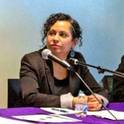
Last January we sat with about thirty Cubans in a community arts center in Boyeros, on the outskirts of Havana, Cuba. The group included artists, teachers, social workers, government officials, architects, engineers and health professionals, all working in Boyeros. We were leading a three-day participatory planning workshop to help this group identify ways that the 1930s Art Deco arts center, currently under renovation, could be used to spark broader community development.
As the first day drew to a close, we felt good about the day’s work. We had turned the Cubans loose in a small group exercise that used art to explore community problems and possible solutions. When the small groups presented their skits, poems and drawings, they yielded laughter along with acute insights on life in Boyeros. Following time-honored popular education principles, we kept the focus on the Boyeros community and left our Boston planning experiences off the table. But when it came to evaluating the day’s work, the recurring comment was, "We would like the compañeros from Boston to tell us how they do planning at home."
Since shortly after its 1959 revolution, Cuba’s variety of socialism has featured both large-scale planning (physical, economic, social) and massive popular participation through active mass organizations and frequent mobilizations. Participatory planning, however, has remained more elusive. Experiments in participatory planning finally began to emerge and then multiply in the late 1980s and 1990s, spurred by the disappearance of Soviet influence and by the economic crisis that paralyzed standard planning methodologies predicated on plentiful resources. Given the country’s high level of collective consciousness and organization, participatory planning would seem like a natural approach for planning in Cuba. Nonetheless, serious obstacles to participatory planning remain, including the veneration of "expertise," which took us by surprise at the end of the first day of our workshop. Our January workshop can serve as a useful window through which to look back at the uneven history of participatory planning in Cuba, and forward to future possibilities.
- Cuba,
- participatory planning
Available at: http://works.bepress.com/lorna_rivera/7/

Read this article on the Planners Network website: http://www.plannersnetwork.org/publications/2003_summer/kennedy_lorna_tilly.htm.